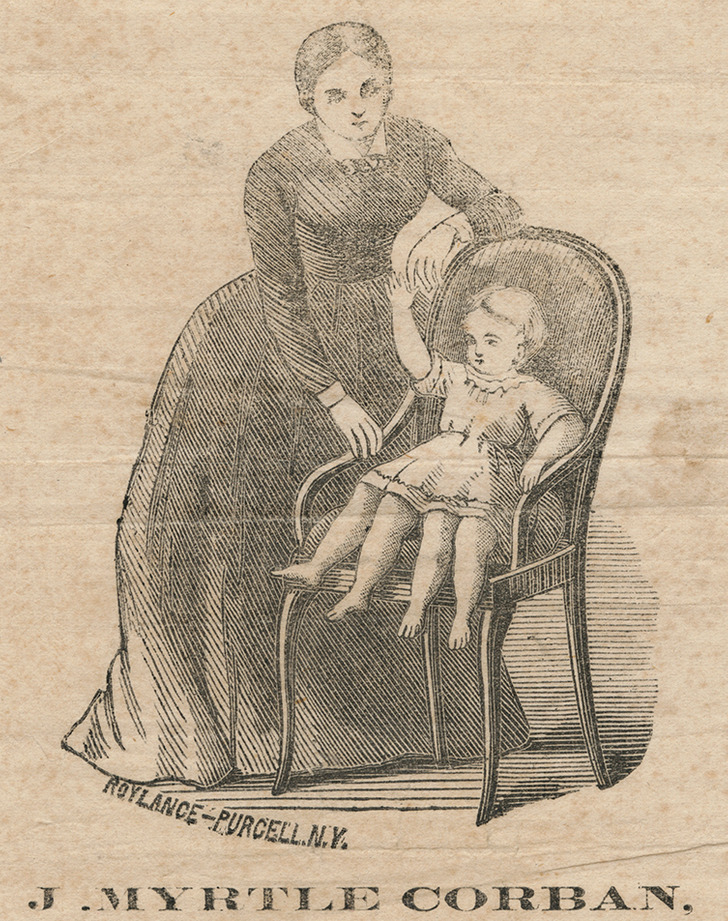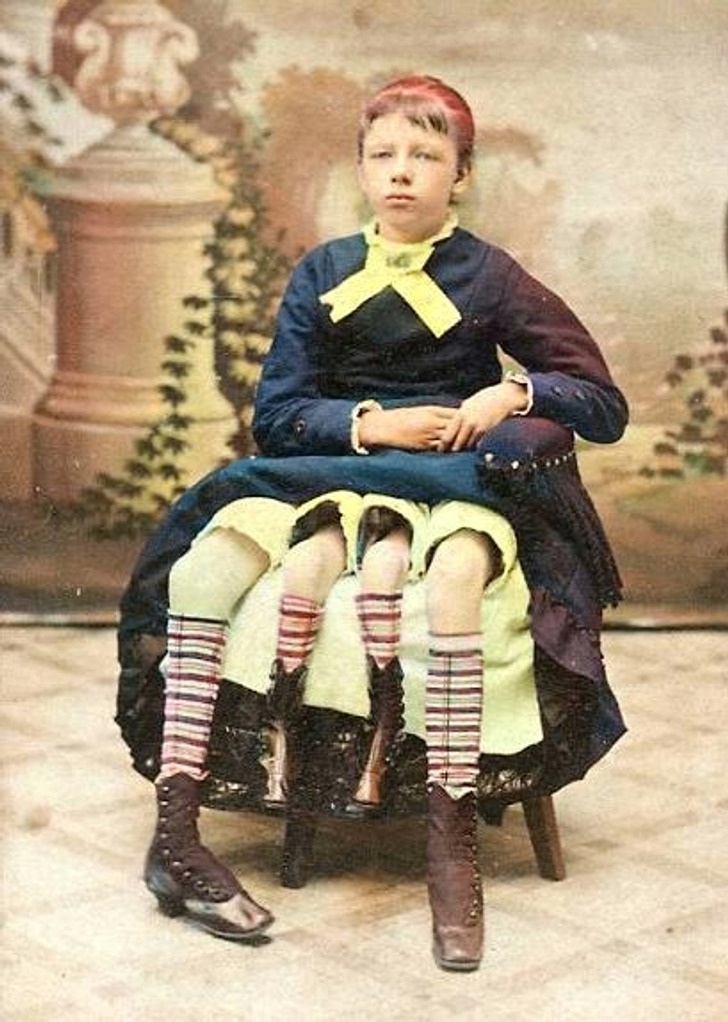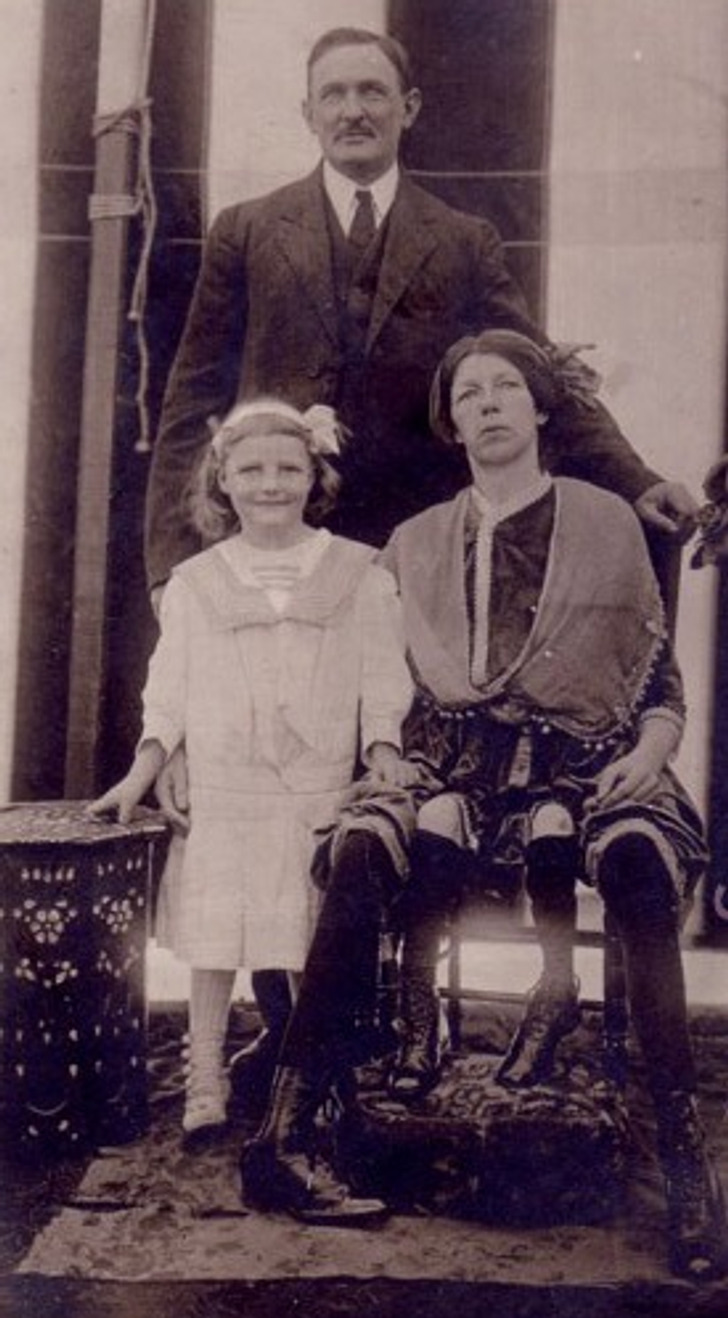Josephine Myrtle Corbin was born with a rare birth defect called polymelia, meaning born with extra limbs, in her case, she had 4 legs, 2 normal ones and 2 smaller ones that grew from her hips. But there was more to it. She also had 2 sets of reproductive organs and 2 pelvises. Because of this rare occurrence, she’s probably one of the few people in history considered wonders. Let’s delve into Myrtle’s story and discover her exceptional life milestones.Myrtle was considered a rare and remarkable case of human development.
Josephine Myrtle Corbin, an American sideshow performer, came into the world in 1868 as a remarkable medical rarity. Affected by a condition known as dipygus, she possessed two lower bodies from the waist down. This unusual phenomenon occurred due to her body axis splitting during development, resulting in two separate pelvises side by side. Remarkably, her smaller inner legs were paired with one of her outer legs. While Myrtle could move her inner legs, but they were too weak to walk on.
Born in Tennessee to her parents, William and Nancy, Myrtle’s arrival brought both wonder and concern. At 25, her father, William, and 34-year-old mother, Nancy, welcomed the unique little Myrtle into their lives. Medical professionals noted that if Myrtle had been delivered breech, with her bottom first, it could have been potentially fatal for both her and her mother. Thankfully, Myrtle’s early days were promising, as she displayed signs of strength, weighing 10 lb (4.5kg) just 3 weeks after her birth.
Myrtle’s father was facing financial hardship and had to think of ways to support his growing family.

© Charles Eisenmann (1855-1927) / Wikimedia Commons, © Public domain, © Palette.fm
At the age of 5 weeks, people had the opportunity to visit William Corbin and marvel at his four-legged daughter for a small fee. As the years passed, Myrtle grew up accustomed to the constant stares and astonishment from those who encountered her rare condition. Her inner legs never fully developed, her right foot was clubbed, and both of the smaller legs had 3 toes on each foot.
Over the following decade, William took Myrtle on a journey across the country, where she participated in fairs, sideshows, and dime museums. By the time she turned 14, she had achieved success and managed to secure a lucrative contract paying her an unusually high salary of $250 per week.
The four-legged girl, Myrtle, had a younger sister named Ann, who fortunately did not suffer from any birth defects.
Myrtle married when she was 18 and later became a mother.

© James R. Applegate (1849–1910), Philadelphia / Wikimedia Commons, © Public Domain, © Palette.fm
As Myrtle entered adulthood, she grew weary of the constant attention she received due to her condition. At 18, she decided to marry James Bicknell, a medical student, after which she retired from her performing career. Interestingly, her fame had inspired others to attempt to fake her unique deformity, but all of these impostors were eventually exposed as frauds.
A year into their marriage, Myrtle experienced troubling symptoms like fever, nausea, headaches, and side pains. Concerned, she sought medical attention, and to her disbelief, the doctor revealed that she was pregnant on her left side. Myrtle skeptically responded, saying, “If it had been on my right side, I would come nearer believing you are correct.” The pregnancy proved challenging for her health, and doctors even advised her to consider an abortion due to the severity of her illness. However, Myrtle managed to recover swiftly.
Over the following years, James and Myrtle welcomed seven more children into their family. Tragically, only 5 of them survived infancy, 4 daughters and a son.
© Unknown author / Wikimedia Commons, © Public Domain
The family lived a quiet life until their 5 children reached adulthood. Then Myrtle re-entered the show business. In 1909, when Myrtle was 41, she was a part of Huber’s Museum exhibit, appearing as The Four-Legged Girl from Cleburne, Texas. She often dressed her 4 legs in matching shoes and socks, to the audience’s delight. She was making $450 per week at the time.
In 1928, Myrtle developed a skin infection on her right leg, and the doctor diagnosed her with erysipelas or a strep infection. A week later, on May 6th, 1928, Myrtle passed away. Her casket was covered in concrete, and family members kept watch until it was fully cured to prevent grave robbers from stealing her remains.
Almost a century later, Josephine Myrtle Corbin Bicknell continues to inspire others by proving that even in the 19th century, a woman could forge a successful career and become a mother all at once.
My Neighbor Threw Rotten Tomatoes at My Front Door Because I Didn’t Put up Halloween Decorations ‘Soon Enough’


While my seven-year-old daughter fought for her life in the hospital with severe pneumonia, my neighbor decided to “decorate” my front door with rotten tomatoes. All because I hadn’t put up Halloween decorations early enough for her liking.
You know those days when life hits you so hard you can barely catch your breath? That’s been my reality lately. Between double shifts at the diner and spending every spare moment at the hospital with Lacey, I’ve been running on caffeine and sheer determination.

A woman standing in a hospital | Source: Midjourney
It started with what I thought was just a cold. Lacey came home from school one Tuesday with a slight cough. It didn’t look like anything serious. But by Friday night, she was burning up with a fever.
“Mommy, I don’t feel good,” she said while trying to catch her breath.
That was the point where I realized something was extremely wrong with her.
I didn’t even wait for an ambulance. I wrapped her in a blanket and drove to the ER like my life depended on it because it did. My life is Lacey.

An emergency sign outside a hospital | Source: Pexels
The doctors moved fast, thank God.
Words like “severe pneumonia,” “aggressive infection,” and “extended stay” flew around while they ran tests on her. After what seemed like an eternity, the ER doctor finally sat down with me.
“The infection’s in both lungs,” he explained gently. “She’s going to need intensive treatment. We’re looking at a minimum of three weeks in the hospital.”
“Three weeks?” I looked at him with wide eyes. “But… but I have to work. The insurance… it doesn’t cover everything.”

A woman talking to the doctor | Source: Midjourney
He squeezed my shoulder. “Let’s focus on getting her better first. You can speak with our financial department about payment plans.”
I’ve been doing this solo parent thing for five years now, ever since Mark decided his twenty-something secretary was more appealing than his family responsibilities. The divorce knocked us down hard, but my daughter Lacey and I aren’t the type of people who’d give up. We’re fighters. We didn’t let Mark’s poor decisions affect us.
I worked as a waitress and picked up extra shifts after the divorce. Living on a single income taught me how to stretch every dollar and avoid unnecessary expenses.

A person holding their empty wallet | Source: Pexels
Last year, we even managed to move into this supposedly “better” neighborhood. You know, the kind where people treat their HOA guidelines like they’re the Constitution.
“Alice, hon, you’ve got tables 4 and 6 waiting,” Maria called out during another hectic dinner shift.
She’s been my rock through all this, covering for me when hospital visits run long.
“On it!” I called back, tucking my phone deeper into my apron pocket after checking another message from Lacey’s doctors. These hospital bills were piling up faster than I could count, but what choice did I have?
My baby needed me, and I had to work harder for her.

A woman working as a waitress | Source: Pexels
“You look dead on your feet,” Maria said while refilling coffee cups. “When’s the last time you got some real sleep?”
I just shook my head. “Sleep’s a luxury I can’t afford right now. Between the hospital visits and these double shifts…”
“At least you’ve got good neighbors to help out, right?” Maria asked.
I let out a bitter laugh thinking about Carla from two doors down. That woman could give surveillance cameras a run for their money.
Ever since we moved in, she’s appointed herself as the neighborhood’s personal CNN. Carla’s Nosy Network.

An older woman standing outside her house | Source: Midjourney
Just last month, she caused a whole drama with the Hendersons across the street. They’d painted their front door navy blue. It’s a perfectly normal color, right?
Well, Carla didn’t just notice it. She measured the paint swatch against the HOA handbook, took photos at different times of day, and then sent a 500-word email to everyone about how it was “Midnight Navy” instead of the approved “Classic Navy.”
The poor Hendersons had to repaint their door to avoid a fine.

A house with a blue door | Source: Midjourney
“Remember that time she counted how many people came to Janet’s book club?” I told Maria. “She actually reported Janet to the HOA for ‘running a business from home’ because there were more than six cars parked on the street. It was a book club, for heaven’s sake!”
Carla’s the type who doesn’t just check her mailbox. She watches everyone else check theirs too. She keeps a literal notebook of when people bring their trash cans in and out.
I swear I’ve seen her peeking through her blinds so often.

A person’s hand on window blinds | Source: Pexels
That’s why I wasn’t surprised when she started blowing up our HOA group chat about Halloween preparations in mid-September.
Every day brought a new message about “maintaining neighborhood standards” and “preserving property values through seasonal charm.”
But with Lacey in the hospital, festive decorations were the last thing on my mind.
That’s when my phone buzzed again. Another message from Carla, but this time sent directly to me. My heart raced when the notification popped up on my screen.
I couldn’t believe my eyes when I read her text.

A woman reading a message on her phone | Source: Midjourney
Are you special or something? Why isn’t your house decorated for Halloween? It’s almost the end of October, and your house is the only one ruining the vibe. Do you want to spoil Halloween for the whole neighborhood? It’s embarrassing.
I had to read it twice to believe someone could be this insensitive.
I took a deep breath before typing out a response, trying my best to keep it professional despite my rising anger.

A woman using her phone | Source: Pexels
Carla, I’m sorry I haven’t decorated. I’ve been in the hospital with my daughter for two weeks now. She’s really sick, and all my money’s gone to medicine and bills. I’m not sure I’ll be able to put anything up this year.
Well, I didn’t get a response from Carla, so I thought she must’ve found something else to worry about. I had no idea how wrong I was.
After three long weeks, Lacey was finally well enough to come home.

A woman driving | Source: Pexels
We pulled into our driveway at sunset as we discussed how good it’d feel to finally sleep in our beds.
That’s when the smell hit us. A putrid, sickening odor that made my stomach turn.
Our front door was completely covered in smashed, rotten tomatoes. The red pulp dripped down the wood and seeds stuck in every crevice. But the pièce de résistance? A note was taped right in the middle. It read:
Now at least it looks a bit like Halloween. No need to thank me.

A door with a note smeared in tomato pulp | Source: Midjourney
“Mommy, why does our house smell bad?” Lacey asked.
I didn’t have an answer to my daughter’s innocent question. I was so angry that my feet were almost shaking.
I got Lacey settled inside despite the garage, made sure she was comfortable in bed, and then stormed over to Carla’s house. I could see her peeking through her blinds as I approached.
When she opened the door, that smug smile on her face made me want to scream.
“Oh, hey there. Enjoying the Halloween decorations?” she asked.

An older woman smiling | Source: Midjourney
“Are you kidding me, Carla?” I snapped. “I told you what I was dealing with. You know my daughter’s been in the hospital, and you still did this?”
She rolled her eyes like I was being dramatic. “Look, I just thought you were making excuses. Everyone decorates, and it’s unfair for you to spoil it for the rest of us. I thought a little tomato juice might remind you to get into the spirit. You didn’t put up the decorations soon enough. Not my fault.”

An older woman talking to her neighbor | Source: Midjourney
Before I could respond, her husband Dan appeared behind her. He was horrified after hearing his wife’s confession.
“Carla, what the hell is wrong with you?” he demanded. “You did what?”
The next few minutes were pure chaos.
Dan pulled Carla inside, and I could hear him confront her. The muffled argument was punctuated by phrases like “completely unacceptable” and “lost your mind.”
When Dan returned to the door, his face was red with embarrassment.

A close-up shot of an older man’s face | Source: Midjourney
“I’m so sorry,” he said. “I had no idea she’d do something like this. I’ll clean up your door and pay for any damages. Carla, you better apologize right now.”
Carla emerged and muttered what had to be the most insincere apology I’d ever heard.
But this isn’t where the story ends. Karma intervened a few hours later and taught her an unforgettable lesson.
That night, the strongest storm of the season hit our neighborhood.

A stormy sky | Source: Pexels
The wind howled like a banshee, and the rain came down in sheets. When I looked out my window the next morning, I couldn’t help but laugh at the irony.
Carla’s elaborate Halloween display – the one she’d been bragging about for weeks – was absolutely decimated. Her precious inflatable decorations were scattered across three yards, her meticulously carved pumpkins had turned to mush in the rain, and her collection of “premium” skeletons lay broken and tangled in the bushes.
Mother Nature had delivered the perfect revenge.

Broken Halloween decor | Source: Midjourney
Dan followed through on his promise, showing up early the next day with cleaning supplies and groceries.
“I can’t apologize enough,” he said while scrubbing the last bits of tomato off my door. “How’s your daughter doing?”
“She’s getting stronger every day,” I replied. “Thanks for asking. And thanks for, uh, everything else.”
Carla hasn’t spoken a word to me since then and I’ve been loving the silence. When I pass by her house these days and see her bare lawn, I can’t help but smile a little.




Leave a Reply